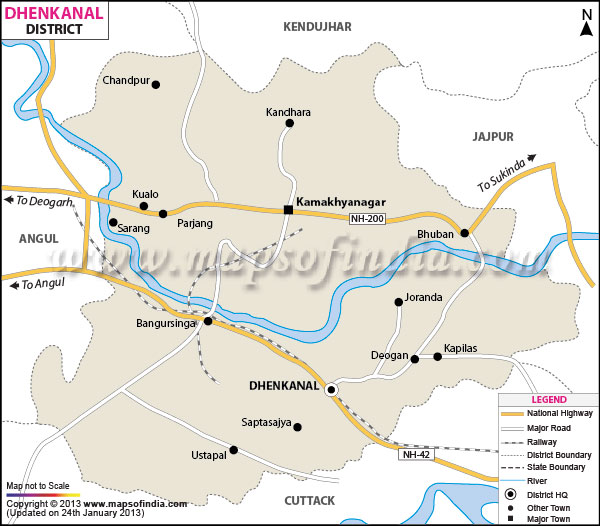Dhenkanal District is an administrative district of Orissa. This district, situated on the Cuttack-Sambalpur road is believed to have derived its name from a Savara chief named Dhenka, who have ruled the land. The significance of Dhenkanal District lies in the profound historical evidences and interest with which Dhenkanal is endowed. This district of Orissa is popular as a famous religious site for a period of over hundred years. The antiquity of Dhenkanal District is evident from the historical details of the district. Dhenkanal District is bounded by the Keonjhar District in north, Cuttack District in south, Jajpur District in the east and Angul District in the west. This district lies between longitudes 85 degree 58 minutes to 86 degree 2 minutes east and latitude 20 degree 29 minutes to 21 degree 11 minutes north.
History of Dhenkanal District
History of Dhenkanal District
As the archaeological evidences depict that the region of present Dhenkanal was inhabited since the prehistoric times when there was no organized administrative authority. However the historical facts of Dhenkanal during the prehistoric times are in dark oblivion, due to the nonexistence of any written documents. Thus, the prehistoric facts of Dhenkanal are solely dependent on the archaeological evidences and the rock inscription. The Nasik rock inscription reveals that during 2nd century A.D, the tract of Dhenkanal was under the Sattavahana dynasty, while in the 3rd and 4th centuries A.D, the Guptas were at the helm of the administration. In the 6th and 7th century A.D, Dhenkanal came in the hands of the Bhauma karas. Finally the Sulki dynasty grabbed Dhenkanal from the Bhauma Karas and continued to be the absolute authority of Dhenkanal till 9th century. As the history of Dhenkanal contemplates, the authority of Dhenkanal has been passed under various kings and chiefs belonging to various dynasties.
During the Somavansi expedition, the vast tract of Dhenkanal was occupied by them who continued to be the sovereign authority of the Dhenkanal for couple of years. But if the history of Dhenkanal is to be followed, the district of Dhenkanal made an active progress during the Gangas, who ousted the Somavansis from their former state. The Gangas, in addition of being sophisticated than the erstwhile kings were the warrior tribes. The unremitting desires of the Ganga kings to be the master of the maximum part of Orissa laid the foundation of their downfall. The incompetent successor of the Ganga rulers could not retain the status of integrated whole of the kingdom and in the later part of their rule, Dhenkanal, including the other parts of Orissa were fragmented into several sections.
Further, historical accounts of Dhenkanal specify that when the Suryavanshis ascended the throne of Dhenkanal, the entire region was disintegrated completely. Hence, the historical documents of disintegrated Dhenkanal during the reign of the Suryavanshis are likely to be non-existent. However, the most accepted view is that the authentic historical details of Dhenkanal are codified right from the time when a tribal chief mainly Dhenka, ruled Ghumuranali, Dudianali and Kantanali encompassing a significant portion of present Dhenkanal. He was a Savara and was a ferocious warrior. He named his kingdom `Dhenkanal` after his name, as the popular faith runs. But the Savara chief was not destined to be the sovereign authority of Dhenkanal for long. Finally Sridhar Bhanja of Besalia defeated and killed the chief in the battle. Moreover, the history of Dhenkanal District was concluded with the Bhanja rulers as the supreme authority of the whole of Orissa till the independence of India. Finally the princely state of Dhenkanal was merged with the Indian Union, after the country`s independence in 1947.
Dhenkanal District contains a centre of religions movement called `Mahima Dharma` since last 100 years or more and spread over through out the Indian Union. The religious movement in the medieval period also touched to this district. The famous `Kapilash Hill`, which is popularly known as the `Kailash` of Utkal, lies in this district. Lord Chandrasekhar Mahadev temple is set up at the top of the hill.
Geography of Dhenkanal District
Major portion of Dhenkanal District is covered with dense forest and a long range of hills. Hence, this district is called as the `Home of elephants and tigers for the country`. The climate of the Dhenkanal District is hot and dry, sub humid type with an average annual rainfall of 1696 mm. The average minimum and maximum temperatures are around 19 degree Celsius and 33 degree Celsius respectively. The humidity is generally high varying from 31 percent to 88 percent. The climate is hot during April and May and cold during December and January. The monsoon generally breaks during the month of June.
Economy of Dhenkanal District
Economy of Dhenkanal District is mainly agrarian in character. An agricultural district like Dhenkanal gains much from forests which plays an important role in the economy of the district. The principal forest products are Timber, Bamboo, Fire wood and Kendu leaf. The minor forest products are Lac, Honey, Kenduli Gum, Wax, Mahua flower, Sunari fark, Siali Leaves, Catechus, Tassar Cocoons and other raw materials used for medicine. Some large scale industries like Nilachal Refractories, Utkal Asbestos Ltd, Orissa Polyfibres Ltd, Shakti sugar are also established in this district.
Dhenkanal District has proper educational, healthcare and banking system. Moreover, the tourist places of this region attract the travellers from different parts of the world. Culture of Dhenkanal District is mixed and diverse in nature.












0 comments:
Post a Comment